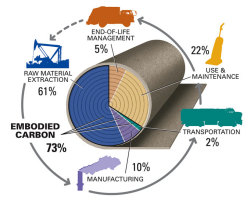Blog Post
New Hub for Information and Action on Embodied Carbon and the 2030 Challenge for Products

- Facts and in-depth information on the embodied carbon of building products
- Industry updates and related articles from Environmental Building News
- Initial research on Product Category Rules (PCR), Environmental Product Declarations (EDPs), and Life Cycle Analyses (LCAs)
- Tools, calculators, databases, and information on relevant standards.
BuildingGreen is committed to supporting the 2030 Challenge for Products by providing timely information on new efforts toward measuring and improving embodied carbon of products and buildings. As quality data becomes more available BuildingGreen will incorporate this information into GreenSpec helping designers to find products with lower than average embodied carbon and manufacturers who are focusing on embodied carbon reductions. Pharos will also include the data over time, making it easy to screen for products by how much they've reduced embodied carbon, alongside VOCs, chemical health hazards and other product data. BuildingGreen will continue, of course, to take a comprehensive view of the impact of building products--including health concerns and other life cycle impacts. Embodied carbon is just one part of this broader picture, all of which needs to be addressed. However, we can no longer overlook the significance of Embodied carbon in the built environment's contribution to climate change. We want to work with you on this. Are you already incorporating embodied carbon of products and buildings in your work? Is this a new complication you haven't really considered yet? Let us know what you think, what you need help with, and any resources we may have overlooked. We aim to help.
Published September 7, 2011 Permalink Citation
(2011, September 7). New Hub for Information and Action on Embodied Carbon and the 2030 Challenge for Products. Retrieved from https://www.buildinggreen.com/news-article/new-hub-information-and-action-embodied-carbon-and-2030-challenge-products



Add new comment
To post a comment, you need to register for a BuildingGreen Basic membership (free) or login to your existing profile.